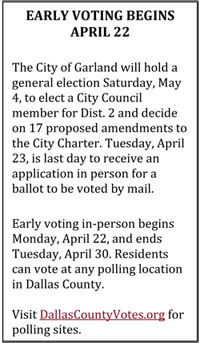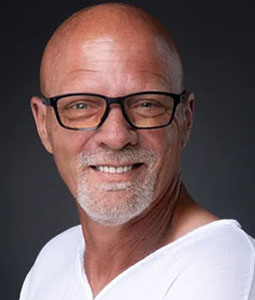A list of questions was recently sent to the candidates for the District 2 City Council seat. The answers were copied and pasted as they were submitted.
Candidate: Eric Stuyvesant
How long have you lived in Garland?
I moved to Garland in June of 2009, so, nearly 15 years.
Why do you want to serve on City Council?
I want to make sure that EVERYONE in District 2 is being represented.
Garland is undergoing some incredible changes, and those changes are directly affecting District 2 residents. Home valuations continue to rise and with the added pressure of recent bonds, many residents in District 2 are feeling the tax pinch. In addition, residential streets, sidewalks, and parking issues continue to concern constituents. I will work to ensure the quality of residential life is as much of a priority as economic development in Garland.
Please summarize your experience/background/knowledge that you feel makes you the right choice for the council seat.
For the City of Garland, I have served on the I-30 TIF Board and the Environmental & Community Advisory Board. I have also held numerous leadership positions in various organizations I belong to.
What personal characteristics do you possess that qualify you for the position?
Critical thinking skills are my greatest asset. I can see the pros and cons of situations before they arise. This is important both in leadership and decision-making. I also can think outside the box. Two detriments to local government are “group think,” and presuming that there is only one way to achieve a result.
Do you believe that more transparency is needed in city government? Or do you feel that there is already an adequate amount of transparency? Why?
We live in a world of cloudy transparency. Garland is no different. Transparency only works if constituents know where and how to find out information that will affect their lives on their own. City officials editorializing information has the potential to be a one-sided narrative, and can murky the water. Clear, concise descriptions in layman’s language are a start at transparency. Follow that up with reasoning that isn’t buried in a Britannica-sized pdf, and I believe the decision-making process in Garland becomes more transparent.
How will you involve your constituents in your decision-making?
It is important to have conversations with people with varying views, to be able to hear, understand, and learn from constituents who have different opinions. Echo chambers are easy, and we see that in every level of government these days. Achieving a consensus, or even a path forward, isn’t difficult when the only people at the table are those you agree with. I will make sure that I have conversations with every interested party before I jump to a decision.
What are some of the things in District 2 that need to be improved/changed? And, how will you go about getting those improvements made?
Economic development should spur community and neighborhood development, and yet residents are still voicing the same concerns they’ve had for years. It’s not a matter of whether it can be done, or should be done, it’s a matter of getting it done. Residents shouldn’t be secondary or tertiary concerns. They should be our primary concern. This can be accomplished by ensuring that every project brought before the council is rated on how it will affect the quality of life of our citizens and our neighborhoods.
What sets you apart from your opponent?
First, my experience serving on Garland City Boards has given me insight into how municipal governing bodies work. Secondly, owning a lawn care company I’m out working in our neighborhoods every day. I know the challenges of District 2. I see them and I live with them daily. Thirdly, my experience in leadership roles in other organizations naturally lends itself to experience in finding manageable resolutions for all stakeholders. Finally, I am not afraid to challenge conventional wisdom, push for new ideas, and amplify the concerns of all of District 2 residents.


